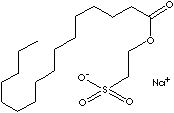SODIUM COCOYL ISETHIONATE
PRODUCT IDENTIFICATION
61789-32-0

H.S.CODE
3402.11
TOXICITY
CLASSIFICATION
PHYSICAL AND CHEMICAL PROPERTIES
white to off white powder or flake
MELTING POINT
SOLUBILITY IN WATER
4.5 - 6 (10% Sol.)
REFRACTIVE INDEX
GENERAL DESCRIPTION AND APPLICATIONS
|
Product |
CAS RN |
| N-Methyl-N-oleoyltaurine | 97-80-3 |
| Sodium N-methyl-N-oleoyltaurate | 137-20-2 |
| Sodium N-methyl-N-lauroyltaurine | 4337-75-1 |
| Sodium lauroyl isethionate | 7381-01-3 |
| Sodium N-methyl-N-cocoyltaurate | 12765-39-8 |
| Sodium cocoyl isothionate | 61789-32-0 |
Sodium Cocoyl Isethionates, coco fatty acid, esters (2-sulfoethyl) and salts (sodium), are mild, biodegradable and high foaming anionic surfactants which provides gentle cleansing and soft skin feel. These compounds are used in skin and face cleansing products such as non-soap cleansing bars, synthetic detergent bars combined by soap as well as body cleansers and shampoos.
SOLID
APPEARANCE
white to off white powder or flake
ACTIVE MATTER
82.0 - 86.0%
pH
4.5 - 6 (10% Sol.)
FREE FATTY ACID
5.0 - 10.0%
MOISTURE
0.5% max
COLOR ( APHA)
35 max (10% solution)
30% SOLUTION
APPEARANCE
ACTIVE MATTER
27.0% - 33.0%
pH
6 - 8
WATER
balance
COLOR ( APHA)
15 max (10% solution)
Carbon distribution: > , C8/10 13 (%) + C12 45 - 55(%) + C14 25(%) + C16 15(%) + C18, < 12(%)
GENERAL DESCRIPTION OF IONIC SURFACTANTS
Ionic surfactants which contain hydrophobic hydrocarbon group connected with one or several hydrophilic groups dissociate into a positively charged cation and a negatively charged anion in an aqueous solution. If the head is negatively charged to carry the surface active properties, it is called anionic surfactant, whereas a positively charged head is the carrier of the surface active properties in cationic surfactants. Typically cationic surfactants are based on the nitrogen atom carrying the cationic charge such as amine and quaternary ammonium product.
Cationic surfactant is considered to be poor cleaners but it contributes to the fabric softening, the disinfecting properties, and the grease-water interfacial tension reducing. Cationic surfactants include quaternary ammonium compounds, amines (primary, secondary, tertiary, diamines, polyamines, amine salts), imidazoline compounds, betaine compounds, and esterquats.
Anionic surfactant is the widely used type of surface active agent for laundry detergents, liquid cleaners and shampoos due to excellent cleaning properties particularly effective at oily soil cleaning and oil/clay soil suspension. Anionic surfactants are deactivated in many hard water. To prevent deactivation, builders should be dosed. Anionic surfactant is used as a emulsifier in cosmetics, tooth paste, cream, shampoo, and acrylic binder. Common soap is an anionic surfactant. Carboxylate, sulfate, sulfonate and phosphate are the polar groups in anionic surfactants. Anionic surfactants include alkyl benzene sulfonate, fatty acid salts, sodium lauryl sulfate, alkyl sulfate salts, sodium lauryl ether sulfate, alpha-olefin sulfonates, phosphate esters, sulphosuccinates, alkyl phenol ether sulfates, and isethionates.